#allergictoslow salestips salespipeline businessmotivation salesoperation salesoptimisation businessdevelopment customerexperience sixfigure
Explore tagged Tumblr posts
Text
FAST-TRACK YOUR SALES SYSTEM WITH AGILE IN 90 DAYS - AND KEEP IT GOING
What if I told you there is a really simple way to accelerate your sales.
Sales leaders know what needs to be done in their sales pipeline but their problem is getting the team’s buy-in to fix it. You’ve got lags, blockages, overloaded people… everything that’s getting in the way of hitting your team targets. If everyone was on board with the fixes everything would happen faster, like a beautifully oiled machine operating smoothly.
Let me show you a system that will improve your sales numbers and fast-track your opportunities in your pipeline.
“It's not a new sales methodology. “
In fact, regardless of what methodology you're using, this will work.
1 - Visualise the problems in your pipeline: All relevant fixes AKA backlog of improvements
You are aware of the fixes that need to happen in your system. The things that are currently not working, your pain-points. You know that a lot of little things need to be improved.
If you look at this simplified pipeline (for the purpose of this article); you can see it goes from Lead Gen→ Opportunity → Proposal → Contract mapped out in Trello.
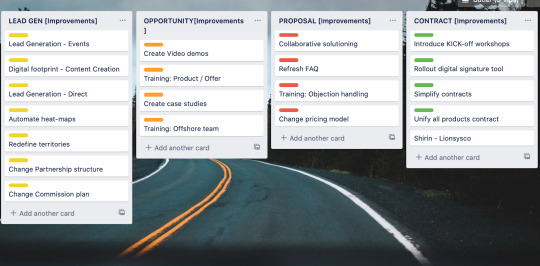
Let's get a sense of the type of improvements I'm talking about:
In the “Lead Gen” stage, we are not using events well to create leads, or we're not using LinkedIn for lead generation.
In the “Opportunity” phase, we don't have enough videos to show the demo, or we don't have any battle cards, or they are out-dated.
In the “Proposal” stage, we don't have a tracking system. So we don't know if customers are using our system or if they are interacting with the case studies or emails that we've sent.
In the “Contract” stage, we know our current contract structure is old, and it's not easy to amend. And it takes a very long time, forward and backward, to get a sign off on a deal.
Pro Tip: To compose a backlog of improvements, think of your dream sales team and sales operation, think what needs to be done. Add that in your list. Get access to this Trello Board here. Duplicate it for your business and take it from there.
2 - Sizing and prioritising the sales pipeline fixes
Each of these improvement cards are associated with a metric. The key question is “How do you decide which one to go ahead with first?”
Actually, you don't!!!? Let’s walk through a case...
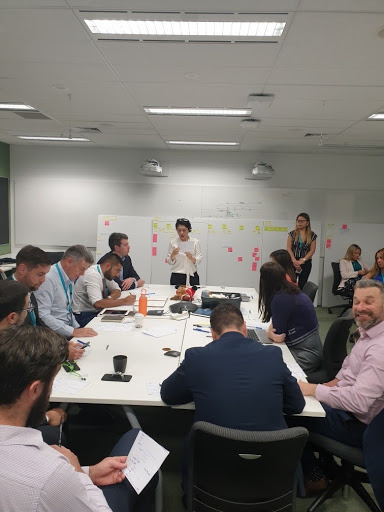
In this picture (above) you can see we have mapped out an end-to-end of a sales pipeline at the back of the room. It has all the steps in the sales pipeline, from beginning to the end.
We invited the sales team. Some of the guns, a couple of the architects, SMEs, some of the newcomers, the hunters, the farmers, anyone that is working on the sales pipeline.In this workshop we asked them to map the pain-points across this end to end pipeline (using the red post-it notes you can see in the background).
Sizing the improvement
Next step is about sizing the issues that the team has highlighted. We ask them to use cards (pictured) to indicate the size and frequency of these problems. Now, everyone can see which one is the bigger problem. Next step we'll ask them to prioritise.
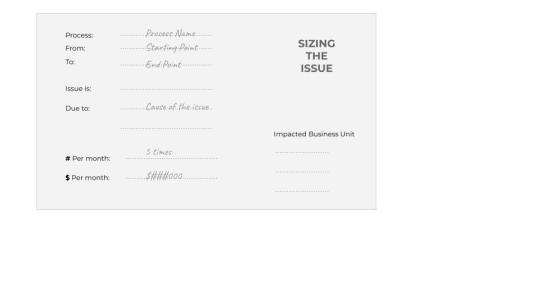
Prioritisation
All problems require attention but not all at the same time. This is actually a specific method of prioritisation. We ask the team, "Which one of these problems is the most important one from our customers’ point of view?" NOT which one is the one that makes more money for us. And you can tell from this picture which one was getting the highest point and will get nominated.
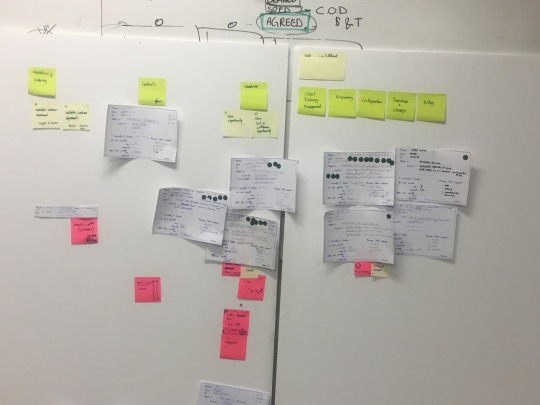
The dot-voting method
The dot-voting method is another option for decision making. This is a democratic method where you nominate the high priority items. This is useful where there is no data available because it harnesses the collective wisdom and team's understanding of customers.
Each participant has 10 dots, in 1,2, 3, 4
They place dots next to issues identified on the sales pipeline.
Issues with the most dots “win” and will be priortised to be resolved.
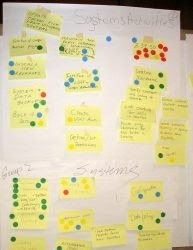
Other names for dot voting are multi-voting, sticker-voting, sticky-dot voting, dot-mocracy and dot democracy.
Pro-tip: To prevent skewed voting from strongly opinionated team members, invite junior participants to place their votes first, while saving stakeholders or subject-matter experts for last. This approach protects the votes (and voices) of those who may be less likely to authentically contribute and may automatically defer to others.
3 - Implementing the Improvement
If we go back to the Trello board, the backlog of improvement cards, let's say the team prioritises three improvement cards for us:
Lead generation Stage: We are light on lead generation, so let's look at LinkedIn. LinkedIn is the future.
Proposal Stage: Our Battle Cards belong to the industrial era or stone age.
We need to install a tracking system to make sure we are measuring the things that we want.
At the beginning of a quarter, we will commit to three prioritised cards. Then we agree for seven sprints we will apply the change and see how we improve on the metric associated with them.
Why 7?
For seven sprints we will do what we need to do, and then we'll stop. Why is it seven? To change a habit or behavior in a person or an organization, which is made of people, you need to hear something seven times and you need to do it 21 times. However, before committing to 21 times, we stop at seven to see if it's working. 7 sprints can also be mapped to a quarter which works well for organisational financial calendars.
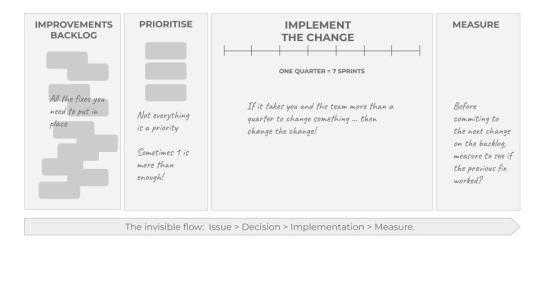
4 - Measuring the impact of change
After seven sprints we stop. We will do a measurement. When we are measuring, we want to always compare the results to get insight to see if it's working or not, or if it helped. We compare that quarter's results with the previous quarter, and we compare that with the last year, same time. That's to make sure that the change and the result is not because of the environment, and is a true change.
5- Zoom in at “Linkedin Lead Generation” Card
Let me look at ANOTHER item, so you get a view of what could be inside it. Let's say the team has never used LinkedIn before. We need to get our sales navigator license. We need to create filters so we know which accounts we're targeting. We need to create the right messaging sequence because we want to have different touch points with our clients. And we want to have a couple of case studies.
At the beginning of a sprint, the team comes together and decides which accounts they want to target. Each day they will update their trackers to what they've done. That's basically a tactical way of looking at the activities. In our sprint review, we say, Okay, how did we go?

TEAM TRACKS THEIR ACTIVITIES RELATED TO THIS
Let me show you a tracker that we put in place a while ago. This was a sequence of messages, the period that we were using it, the delays, between each message and the team’s tracker. So they could show their progress. This is a simple tracker designed to show us the leads, calls and the impact of the change or activity. We go seven sprints with it and at the end we stop and compare the results. It’s as simple as that.
6 - The human element of this system
This system that I showed you allows you to get your team's buy-in.
Remember, you didn't tell them what needs to be done, you ask them and involve them in the prioritisation and decision making process.
What’s important is you’re moving from a "knowing" space to a "doing" space.
Many, in fact all sales leaders, know what needs to be done. But getting their teams to come along with them, that's their challenge. This system is a quite tangible method to get people moving and create momentum and results.
It’s also really helpful in terms of managing noise, if you know what I mean.
7- The metric that rules them all
One other point, probably the most important point of this 45-day plan ; each one of these improvement cards is for improving a specific metric, a number or a percentage. However, the whole system will improve one overarching metric; your "Funnel Velocity".
As you know we have two types of indicators, leading and lagging indicators.
Leading indicators - you straight away see an impact after you’ve put a change in place. These are normally observable, behavioural changes and metrics.
Lagging indicators - are the result of change that we’ve put in place over a period of time.
Funnel Velocity is a lagging indicator.
On a separate note, Funnel Velocity has an element of time to it, and it can be translated to an accounting concept of “Early Revenue Turn-On”.
The two above reasons, being a lagging indicator and having an element of time, funnel velocity is a difficult metric to go after. For you to be able to change that or improve it, you need to do so many things in your system in order to be able to increase the speed of opportunities in your funnel.
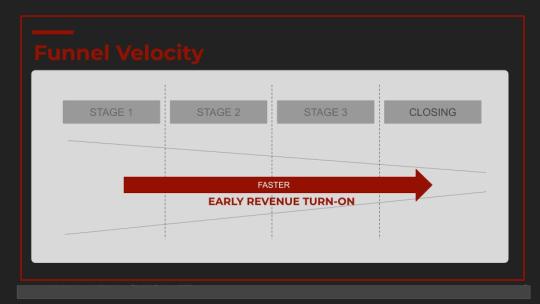
If you are anything like me and you’d like a good challenge: improving Funnel Velocity is a good challenge.
8 - The 45-day Acceleration Plan
To bring all the theory and practical sides together, I've designed and tested a 45-day acceleration plan that is action by action to help you implement the process explained above.
The intention of this plan is to show you how to implement Agile ways of working into your sales pipeline. It’s innovation in leadership applied to sales pipelines to increase numbers
I am passionate about Sales Transformation with Agile. If you have any questions, any problems, or you want me to clarify anything for you, contact me,I would love to talk to you about this.
If video is more ‘your thing’ I’ve also created a video walking through this process for you.
Compose a backlog of improvements, think of your dream sales team and sales operation, think what needs to be done. Add that in your list. Get access to this Trello Board here. Duplicate it for your business and take it from there.
Shirin Danesh is founder of Momentum Pipeline a program designed to make top-tier consulting practices in Agile transformation accessible to a wider range of companies. She invites sales leaders to improve one challenging but rewarding metric - Funnel Velocity. She is an Executive Agile Coach, working with futuristic, caring and ambitious executives to level-up their business. You can read her blog on Agile transformation here.
Article originally published on www.shirindanesh.com
1 note
·
View note